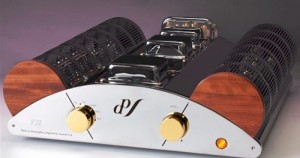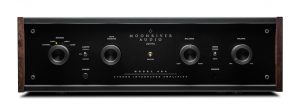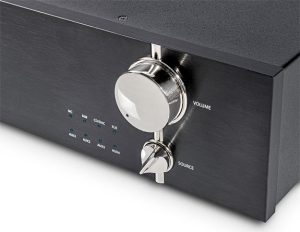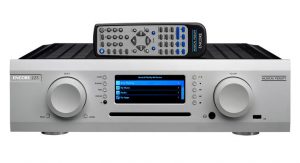I wanted, I really wanted to start this text somehow differently, to escape from the memories from the review of the Chopin MkIV by Struss Amplifiers, but I gave up—though never I had an amplifier from this company, our paths have been crossing in one way or another for some time.
For the last time we met with Mr. Zdzisław Hrynkiewicz-Struss, if I am not mistaken, about sixteen years ago. Maybe seventeen, I'm not sure. I worked at the Audioholic company, a distributor of products from such brands as McIntosh, PSB, Aerial, Nakamichi, and Enlightened Audio Design. In addition to the distribution business, the company rented a large villa on the outskirts of Krakow, in which several rooms were arranged in a way that it could look like at clients homes.
In addition to the devices from our distribution we presented also in the showroom products of several other companies that complemented the portfolio. One of them were amplifiers by Struss. I remember this situation perfectly because at the same time my brother Maciek bought a used 140 Struss amplifier. Nicely made, with an unusual front from polished sheet metal, phono preamplifier and wooden side panels it was a quite famous device at the time.
This was not the first device by Mr. Zdzisław. He had been designing and manufacturing audio devices for a long time, based on the experience gained from the Polish Academy of Sciences, where he was part of the team of electronic engineers. This period lasted for ten years. Then, in the 1985 - 1990 period, he cooperated with Philips and Studer AG—for the latter he designed a reading track for the B77 reel-to-reel tape recorder. Cooperation with Philips allowed him to acquire measuring instruments and electronic components that others could only dream about at the time in our country.
As his spiritual mentor, Mr. Struss mentions Dr. Matti Otali. This, born in 1939, professor of the Finnish University of Oulu who died in 2015, an important figure at Philips Research Laboratories, chief engineer of Harman/Kardon, was an electronic engineer known for developing methods of distortion measurements that were previously unknown—Transient Intermodulation (TIM). TIM were mainly formed after the use of a deep feedback. It is worth mentioning that his appearance in 1973 at the AES conference inspired the Norwegian music producer Svein Erik Børja, who after three years had his first amplifier and company ready—it was called Electrocompaniet.
The first Mr. Struss amplifier based on these experiences was the Struss 01-2 model from 1995. A year later, Struss Amplifiers was founded. As we read in the company's materials and on the manufacturer's website, at the same time the 140 model was designed, and a year later it received the Award of the Audio magazine, in which my reviews began to appear a few years later. The first reviewer was Adam Mokrzycki, today known more as the organizer of the Audio Video Show, that High Fidelity is a media partner of.
A few simple words…
ZDZISŁAW HRYNKIEWICZ-STRUSS
Owner, designer
The DM 250 amplifier is based on the previous experiences of Struss Amplifiers, which were developed and heavily modified by the new Struss Audio team. The important thing is that there are no bipolar transistors in the entire amplification track, we have only used FET technology. The components we used are the best ones available, we have completely eliminated components of Chinese origin.
The preamplifier is an innovative Harmonics and Phase Conversion System that changes the proportions in the harmonic distortion spectrum. The system's solution introduces even harmonics, characteristic of tube circuits, which makes the presentation of music warmer, more realistic, and at the same time is not devoid of the advantages of transistor amplifiers.
Also in this section a number of changes known from Struss Amplifiers have been introduced. They mainly concern the removal of all capacities—both coupling and preventing interference. It required us to design new circuits with the elimination of parasitic interference. We have achieved the required compromise by using SMD components in selected places, and THT elements (traditionally threaded) that are decisive for the sound of the amplifier.
The whole amplifier are two independent monoblocks powered by two 500W toroidal transformers. In output stage, we used a proven and accurately calculated topology of convection cooling, known from earlier Struss Amplifiers. I would like to add that Struss Audio is in the final stage of preparation of separate monoblocks working in class A, with a power of 50 W, next we will propose monoblocks with a power of 400 W, working in the AB class.
DM 250
In 2015, after a series of amplifiers, of which we should mention the models we have tested, Chopin MkIV and R150, the company changed its ownership structure and under the name Struss Audio began to work on a completely new device. The result of the three-years work is the DM 250, which is the subject of this test.
As Mr. Zdzisław says, the basic mechanical structure is similar to what we know from the Chopin model. Completely new is the look and electronics. The front panel has an interesting layout, thanks to dividing it into two parts with a carmine insert and sculptural treatment of its surface. The chromed knobs for volume control and input selection were originally developed for Chopin and nothing has changed since then—they are nice and handy. With a remote control, in the form of a flat, heavy disk, we can only adjust the volume.
The device features four line inputs, one MM phonostage input and one for the power in. One of the inputs is balanced (XLR). De-symmetrizing circuit—the amplifier is an asymmetrical design - is the company's own development. One of the RCA inputs has been equipped with high-quality WBT sockets. Speaker connectors come from the same brand. The amplifier's circuits are protected against overload and short circuit. A power switch is also protected—a latching breaker from the American company C & K has been chosen to protect against accidental switching on or off. And at the same time it is an interesting departure from boring buttons and switches. Similar on/off switches one can find in Japanese amplifiers by SPEC company.
The amplifier is rated at 250W at 4Ω and a its frequency response is 5Hz - 250kHz. Its sound has been tuned so that on the one hand it is as transparent as possible and on the other it sounds nice. The techniques that have been used to achieve that have been developed since 2000, and one of the most important ones is a proprietary solution HPCS (Harmonics and Phase Conversion System): Struss Audio Harmonics and the Phase Conversion System (HPCS) is a solution that enables the listener to move into the real world of music from the comfort of his own home. The amplifier is characterized by the closeness to the ‘tubey sound’ so favored amongst audiophiles, while maintaining all the best features of the transistor amplifier, such as speed and low frequency control. […] The HPCS system is a solution that, while maintaining extremely high technical parameters of the amplifier's path, allows to obtain a sound that is pleasant to the human ear.
Taken from the company's website
As Mr. Zdzisław says, this is about a preamplifier section in which he used J-FET transistors in a system known from tube amplifiers based on pentode tubes. It is about minimizing odd harmonic distortion, leaving even ones at a level that would be acceptable from the point of view of measurements, and which would help in obtaining the target sound. The system was assembled with a mixed by-pass and surface technique, and the number of components was reduced to a minimum.
TEST METHODOLOGY
The amplifier worked in the High Fidelity reference system and was compared to a separate system consisting of the Ayon Audio Spheris III preamplifier and the Soulution 710 power amplifier. As a source, I used the Ayon Audio CD-35 HF SACD Player and simultaneously the reviewed Gold Note Pianosa turntable with Machiavelli Red cartridge. This is a HO MC cartridge, and its output voltage is 2 mV, so it is lower than the nominal preamplifier sensitivity in DM 250. During the test it did not matter, but for peace of mind I would recommend using cartridges with an output voltage of around 4 mV.
The amplifier drove Harbeth M40.1 loudspeakers using Siltech Triple Crown cables. As interconnects I used Acoustic Revive RCA-1.0 Absolute-FM. To power up the device I used Acoustic Revive Power Reference Triple-C. I placed Struss integrated on the Acoustic Revive RAF-48H anti-vibration platform.
Recordings used for the test (a selection):
- Faith No More, Sol Invictus, Reclamation Recordings!/Hostess K.K. RRIPCOO2J, CD (2015); review HERE
- Jamie xx, In Colour, Young Turks/Hostess YTCD122J, CD (2015/2016); review HERE
- Julie London, Julie is her name. Vol. 1, Liberty Records LPR 3006, LP (1955)
- Kendrick Lamar, DAMN., Top Dawg Entertainment/Aftermath Entertainment/Interscope Records/Tidal FLAC 16/44,1; review HERE
- The Weeknd, Starboy, XO • Republic 5727592, CD (2016)
- Suzanne Vega, Close-Up. Vol.1, Love Songs, Amanuensis Productions | Cooking Vinyl COCKCD521, CD (2014)
- Tomasz Pauszek, LO-FI LO-VE, Audio Anatomy AA-006-17-CD, 2 x Master CD-R (2017); review HERE
- Tommy Schneider & Friends, The Hidden Port, Kolibri Records no. 12001, 180 g LP (2012)
- Tsuyoshi Yamamoto, Autumn in Seattle, First Impression Music FIM LP 004-LE, 200 g LP (2001/2011)
- Tsuyoshi Yamamoto, Autumn in Seattle, First Impression Music FIM XRCD 043, XRCD2 (2001)
- Tsuyoshi Yamamoto, Autumn in Seattle, First Impression Music FIM UHD 043LE, CD (2012)
Recorded in 2001, using the Studer A829 tape recorder, album Autumn in Seattle by Tsuyoshi Yamamoto, a Japanese jazz pianist, composer and arranger, was for the owner of the First Impression Music label, Mr. Winston Ma a very special release. The material was recorded especially for his label, and the title track was composed especially for him. It is no wonder that he kept re-issuing it every now and then, when he found a better—in his opinion—way to release this material. The "ultimate" version was, I think, the vinyl one, but he also highly appreciated the digital versions—XRCD2 and 32-bit UltraHD.
I've been listening to this album quite often, because I like Yamamoto and this type of music. But each time I choose another edition—I cannot decide which one is better. And that's because they are completely different. I compared them using the Struss amplifier and the differences mentioned were absolutely clear and unambiguous. Of course, music was the most important element, it gives the sense to the whole, but "watching" how Mr. Ma's thinking about sound has been changed over time is fascinating.
The 2011 version, the 32-bit UltraHD, sounds in a big, intense way. DM 250 also presented it this way, because it presents large plans itself, it is not a "lean" sounding device, so it conveyed this property of the album really well. It is an amplifier that plays "widely", that is, showing big phantom images located in a large space. I could immediately feel that the sound of the version in question was somehow "made" or "shaped". Comparing the XRCD2 disc to the vinyl showed that they are more similar to each other than to UltraHD.
Struss had no trouble presenting a strong, but not entirely contoured, double bass from this album. It is an amplifier that does not chase the selectivity of the lower end of the sound spectrum. It plays with momentum, nice colors, but it doesn't try to clarify everything that happens there. However, it does not stop it from delivering a very good differentiation of the low range, because it was immediately clear that the XRCD2 version is more punctual and faster, and the UltraHD had a less pronounced attack.
The control of this range is really good, this is not the problem—it is perfectly clear though, that it is more about saturating it with colors and mass, not about the ultimate speed of dynamic shifts. You should not think that the DM 250 is only suitable for one type of music—it is anachronistic approach. Both the First Impression Music album and the excellent electronics of Tomasz Pauszek from LO-Fi LO-VE had the right rhythm, pulse, each one its own, and the sound was rich with powerful bass.
Let's play DAMN. by Kendrick Lamar, Starboy by The Weeknd or In Color by Jamie xx, and we will hear the same features: a strong, low bass with creamy colors and a pleasant, warm attack. I think that such a presentation of bass range is responsible to a large extent for amplifier's momentum, for such a nice saturation of the sound. Because the whole band is presented in such a way, that is, warm and dense. And it did not matter whether I listened to sophisticated jazz productions or electronics, this aspect was readable with all recordings.
The latest Struss amplifier build a strong foreground. This is a device that celebrates human voices, gives them seriousness and saturates with meanings. I liked it very much and it perfectly harmonized with the philosophy behind the Harbeth speakers. So if you listen to this type of music and think that only tube amplifiers can offer you what you need, think again while listening to DM 250. The voices are incredibly intimate with it, have a large volume and are palpable. They are rich and very natural. Although we have the impression, something like an aftertaste of the warmth applied to them.
The first 10 this device produces is in class A, there is a small feedback and very low TIM distortion, it is also based on field-effect transistors (FETs). Each of these techniques when used separately warms up the sound. Here, all together were very well combined, reminding me not only what I know from the Qualiton A50i amplifier, but also class D elinsAudio Concerto amp. Which proves that there is something like the aesthetic community, taste and it can achieved using various solutions.
In the case of the Struss DM 250 it results in warmth, density, saturation and incredible momentum. The attack seems rounded, but there was nothing lacking in the sound of cymbals, brass instruments, in the beat of the drums. It was perfectly clear, however, that this is a "long-distance" device in which the listener's attention focuses on richness and sustaining of the sound, not on the attack. The dynamics may seem a bit calmed down, at least if we listen to something clearly open clearly dynamic. This, however, only matters in a short demo, it becomes an advantage during a long listening session.
Also, decaying is a bit masked, and that is probably why the sounds located on the axis, in the foreground, seemed to be displayed in my room instead of taking me into the space, where the music was recorded. They were large, rich and dense, and had large, nice bodies. They were, however, placed "here and now", and the reverbs and acoustics of the interiors were tempered. Paradoxically, classical music in the chamber edition gained from it because the performers were close to me, there was no distancing them from me at the expense of reverberation.
Summary
This is a really good amplifier by Mr. Zdzisław—he is beautifully saturated, dense, but he does not drown everything into mush. Its high tones have exceptional ease in filling the band without brightening or sharpening. The bass is incredibly deep and powerful, although it does not try to compete with the best one in terms of control and selectivity. It is supposed to be just a good filling and a foundation for the rest of the band.
As you can see, the most important part of the band is midrange. The vocals, small chamber ensembles sound great, but so does electronic music. Despite so shaped tonality, it is a very universal amplifier, because it delivers a very fast and clean sound, although it is hidden under colors and saturation. The phono preamplifier is a nice addition here, but only high-quality digital sources and phono preamplifiers will allow the DM 250 to show everything that I've talked about. Congratulations!
DESIGN
The DM 250 is a medium-sized integrated amplifier and the manufacturer calls it: "dual mono" design. The point is that there are two monoblocks powered from separate transformers. Its front panel is very pretty—divided into two parts by a carmine ribbon looks really nice. This type of motif is not a novelty, because in a different form we know it from elinsAudio devices, but you can see that it is about using a similar idea, and not duplicating it.
Front and back
The front is made of thick anodized black and carmine aluminum. It is not flat, as usually, but slightly bowed, which makes the whole look very "architectural". Its production was undertaken by a company from Canada.
We know the manipulators from Chopin—there is a small volume knob and input selector; the latter can also disconnect the amplifier and preamplifier section, when user want to include the device in the home cinema system. However, the knob adjusting the signal level at the headphone output has disappeared—the company has given up this function. The selected input is indicated by blue LEDs. Quite unusual, known from industrial devices, is the power supply switch—it has a latch that prevents accidental switching on or off of the device.
On the back we can find separate input marked as CD/DAC—these are high quality WBTs—and loudspeaker connectors of the same company. The other RCA inputs are classic one, soldered to the printed circuit board. Since the amplifier was designed for export to the USA and Canada, there is also a balanced XLR input and, as already mentioned, a power-in input.
The chassis, prepared by one of the companies located near Warsaw, is made of bent, galvanized steel sheets, and the top wall is varnished. From the inside manufacturer used a bituminous mat to damp vibrations. The amplifier stands on aluminum feet with felt washers.
Inside
The front panel of the amplifier shows the "Dual Mono" writing and on the rear the "Dual Mono Amplifier" one. When one lifts it it is immediately clear that despite the small dimension, there is a lot of copper and aluminum in it—the term "dual mono" means a separate power supply for both channels. Amp features two large toroidal transformers with a power of 500 W each, mounted on a thick, copper-plated platform. There are also four, two for each of the two channels, capacitors with a total capacity of 60,000 μF in the power supply section to suppress ripples from the power grid.
The power amplifier section is based on the own Struss patent RP No. 176514. It is a coupled system without capacitors, based entirely on field effect transistors. Both channels share the same PCB, a large part of which has been surface mounted. The transistors were bolted to a 15 mm thick aluminum plate. Along with a large heat-sink and casing, it dissipates heat from the output transistors - two complementary pairs per channel of N-MOSFET field-effect transistors (IRFP240 + IRFP9240). Bolting the transistors to a thick, vibration-resistant plate would reduce their vibrations and the effect of "microphoning". Today, it is known that this effect well-known from tube devices also affects transistor circuits.
Same goes for the preamplifier section. It features a separate PCB and is screwed next to the back panel. It is based on J-FET transistors operating in a similar arrangement to pentodes in tube systems, thanks to which the 3rd harmonic has been minimized, leaving stronger second one. This will help in obtaining a more "tube", and in fact more natural and pleasant sound. The inputs are switched using relays, and the CD input appears to have a shorter signal path. The phono input works with a single Texas Instruments integrated circuit, that had all markings removed from it. The volume control potentiometer comes from the Alps company and long interconnects deliver signal to it.
Remote control
The remote control is interesting—it is round in shape and quite heavy. One can control volume with it. It was designed to be operated while placed on a flat surface.
Technical specifications (according to manufacturer)
- Rated power: 130W/8Ω | 250W/4Ω
- Frequency range: 5Hz – 250kHz (- 3dB/1W/8Ω)
- Output impedance: 0.10 Ω
- THD:
- 0.1 % @ 1W/8Ω
- 0.025 % @ 130W/8Ω
- Slew rate: 200V/μs
- Dynamics: 140dB
- S/N weighted noise: 145dB (IHF - A)
- Input sensitivity:
- RCA: 500mV | XLR: 250mV | MM: 3mV
- power amplifiers: 0.775V
- Input impedance:
- RCA: 100kΩ | XLR:22kΩ | MM: 47kΩ
- power amplifiers: 47kΩ
- Power consumption: 40VA – 800VA (peak)
- Class A operation: 2 x 10W
- Dimensions (W x H x D): 430 x 102 x 338mm
- Weight: 16kg
STRUSS in High Fidelity
- TEST: Struss Amplifiers Chopin MkIV integrated amplifier
- TEST: Struss Amplifiers R150 integrated amplifier
Struss DM250 Integrated Amplifier
Price (when reviewed): 8000 EUR
STRUSS AUDIO SP. Z O.O.
Aleja Komisji Edukacji Narodowej 36/112B
02-797 Warszawa | Polska
MADE IN POLAND
Provided for test by: STRUSS AUDIO
Text: Wojciech Pacuła
Images: Wojciech Pacuła
Translation: Marek Dyba
















































